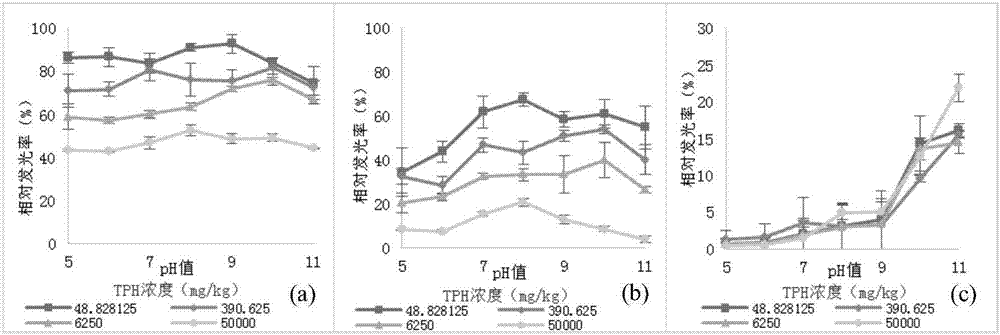Method for quickly evaluating ecological toxicity of petroleum-contaminated soil
A technology for oil pollution and soil biology, applied in chemiluminescence/bioluminescence, analysis by chemical reaction of materials, instruments, etc., can solve the problems of long time, low efficiency, unable to reflect the comprehensive biological toxicity of soil oil pollution, etc.
- Summary
- Abstract
- Description
- Claims
- Application Information
AI Technical Summary
Problems solved by technology
Method used
Image
Examples
Embodiment 1
[0041] Embodiment 1, the selection of induction strain
[0042] Three common luminescent bacteria, Vibrio fischeri, Photobacteriumphosphoreum T3 and Vibrio qinghaiensis Q67 were selected to compare their ability to quickly recover from the freeze-dried state, and their effects on oil pollution According to the concentration sensing range of pollutants and the luminescent response under different environmental factors, luminescent bacteria with strong resurrection ability, high sensitivity and strong stability were selected as soil petroleum pollutant sensing bacteria.
[0043] (1) Resurrection ability of luminescent bacteria
[0044] Compare the time and luminous brightness required for the three kinds of luminescent bacteria to recover from the freeze-dried powder state to normal luminescence (such as figure 1 As shown), it was found that Vibrio fischeri and Photobacterium luminescens T3 had continuous and stable luminescence in 0-20 minutes, and the intensity of luminescenc...
Embodiment 2
[0048] Embodiment 2, the determination of the environmental index of vibrio fischeri
[0049] The environment can affect the growth and metabolic process of luminescent bacteria, thereby affecting their luminous intensity and stability. In order to eliminate the influence of environmental conditions on the luminescence effect of the sensing strains, the luminescence intensity and stability of Vibrio fischeri ( image 3 ). Environmental factors include pH, salinity, temperature.
[0050] It can be seen that Vibrio fischeri has no significant change in the range of pH7-9, and when the pH value is greater than 10, the relative luminescence rate decreases slightly. The relative luminous rate of Vibrio fischeri tends to be stable under the condition of 0-5% salinity, and the relative luminous rate is slightly higher than the average level when the salinity is 2-4%. The luminescence response of Vibrio fischeri was relatively stable at 0-10°C, and when the temperature was higher t...
Embodiment 3
[0052] Embodiment 3, the selection of soil petroleum pollutant extractant
[0053] According to the demand that the extractant not only maintain the activity of luminescent bacteria, but also quickly and efficiently extract petroleum pollutants in the soil, Tween-20 (Tween20), Tween-80 (Tween80), polyethylene glycol octylphenyl ether ( Triton X100), sodium dodecyl sulfate (SDS), sodium dodecylbenzenesulfonate (SDBS) and rhamnolopid (Rhamnolopid) these 6 surfactants are used as alternative extraction agents to select the oil pollutants in the soil extractant.
[0054] The relative luminous rate (%) of Vibrio fischeri in different surfactants of table 1
[0055]
[0056] Comparing the luminous intensity (table 1) of vibrio fischeri in 6 kinds of surfactants with 1% concentration, vibrio fischeri is under Tween20, Tween80, Triton X100, SDBS and Rhamnolopid environment relative luminescence rate is more than 92%, They can survive normally, indicating that these extractants ar...
PUM
 Login to View More
Login to View More Abstract
Description
Claims
Application Information
 Login to View More
Login to View More - R&D
- Intellectual Property
- Life Sciences
- Materials
- Tech Scout
- Unparalleled Data Quality
- Higher Quality Content
- 60% Fewer Hallucinations
Browse by: Latest US Patents, China's latest patents, Technical Efficacy Thesaurus, Application Domain, Technology Topic, Popular Technical Reports.
© 2025 PatSnap. All rights reserved.Legal|Privacy policy|Modern Slavery Act Transparency Statement|Sitemap|About US| Contact US: help@patsnap.com



